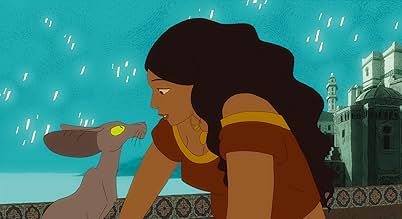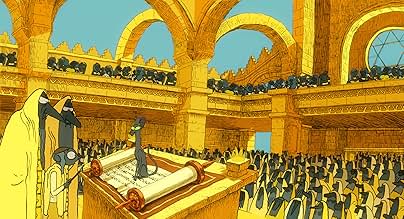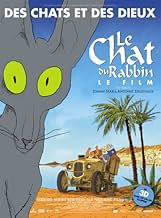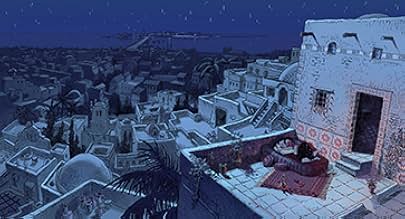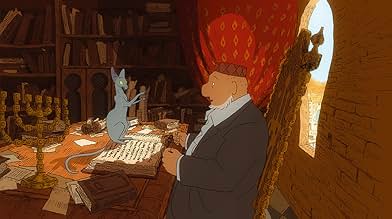CALIFICACIÓN DE IMDb
7.1/10
3.9 k
TU CALIFICACIÓN
Agrega una trama en tu idiomaSet in Algeria in the 1920s, a rabbi's cat who learns how to speak after swallowing the family parrot expresses his desire to convert to Judaism.Set in Algeria in the 1920s, a rabbi's cat who learns how to speak after swallowing the family parrot expresses his desire to convert to Judaism.Set in Algeria in the 1920s, a rabbi's cat who learns how to speak after swallowing the family parrot expresses his desire to convert to Judaism.
- Dirección
- Guionistas
- Elenco
- Premios
- 3 premios ganados y 4 nominaciones en total
Hafsia Herzi
- Zlabya
- (voz)
Mohamed Fellag
- Le Cheikh Sfar
- (voz)
- (as Fellag)
Wojciech Pszoniak
- Vastenov
- (voz)
- (as Wojtek Pszoniak)
Jacky Ido
- Le Chef de la Tribu
- (voz)
- (as John Pucc')
Opiniones destacadas
I really enjoyed this film. It's brilliantly drawn, charming, discusses real events from history, and touches on philosophy. It also takes its time, which is refreshing nowadays. Clearly a lot of work went into this piece of art, which doesn't attempt to be a money making blockbuster.
It was neat to see another famous cartoon character make a cameo appearance midway through the film.
I'd really like to see more films like this. 8/10. Great work.
And now my usual Lorem Ipsum to satisfy IMDb's ten line requirement: But I must explain to you how all this mistaken idea of denouncing pleasure and praising pain was born and I will give you a complete account of the system, and expound the actual teachings of the great explorer of the truth, the master-builder of human happiness. No one rejects, dislikes, or avoids pleasure itself, because it is pleasure, but because those who do not know how to pursue pleasure rationally encounter consequences that are extremely painful.
It was neat to see another famous cartoon character make a cameo appearance midway through the film.
I'd really like to see more films like this. 8/10. Great work.
And now my usual Lorem Ipsum to satisfy IMDb's ten line requirement: But I must explain to you how all this mistaken idea of denouncing pleasure and praising pain was born and I will give you a complete account of the system, and expound the actual teachings of the great explorer of the truth, the master-builder of human happiness. No one rejects, dislikes, or avoids pleasure itself, because it is pleasure, but because those who do not know how to pursue pleasure rationally encounter consequences that are extremely painful.
What an excellent animation, a very pleasant surprise ! Able to talk (not to much insisting on the religious side) about Judaism, Jews and Muslims all together without being heavy, pedant nor dogmatic and with a great touch of humour, I loved that. The drawing are very well made, the dialogues (rather simple, like my comment) have the right touch to make you smile... and the cat is just perfect !
Usually I avoid every movie talking about Judaism, not because of Judaism itself (I am an atheist), but for political reasons : since 1967, I am fed up with all the propaganda made for (sionism and) Israël. I mean the state, not the people living there. For a country created on foreign lands which did not belong to the Jews more than it did to the Palestinians... and the last mentioned were already there... ! Personnaly, I have no problem to speak and communicate with any Israelis, Arabic or Jew, unless he/she comes along with his/her Uzi or AK-47 and puts it in front of my noise :-) And I am also fed up with the brainwash in most newspapers and in TV channels made since WW2, as if the Jews were the only ones who suffered and died during the six sad long years... Why Russian or Polish couldn't also lament for 70 years ?! Imagine the newspapers, filled with these types of articles : it could last for 300 years !!!
Well, back to this funny animation, I will recommend it to my friends and/or to anyone who could enjoy something fresh, original, out of the main stream blockbusters. I agree there are some missing explanatory parts, but I don't care, I enjoyed the whole part.
10/10
A film is never really good unless the camera is an eyes in the head of a poet Orson Welles
Usually I avoid every movie talking about Judaism, not because of Judaism itself (I am an atheist), but for political reasons : since 1967, I am fed up with all the propaganda made for (sionism and) Israël. I mean the state, not the people living there. For a country created on foreign lands which did not belong to the Jews more than it did to the Palestinians... and the last mentioned were already there... ! Personnaly, I have no problem to speak and communicate with any Israelis, Arabic or Jew, unless he/she comes along with his/her Uzi or AK-47 and puts it in front of my noise :-) And I am also fed up with the brainwash in most newspapers and in TV channels made since WW2, as if the Jews were the only ones who suffered and died during the six sad long years... Why Russian or Polish couldn't also lament for 70 years ?! Imagine the newspapers, filled with these types of articles : it could last for 300 years !!!
Well, back to this funny animation, I will recommend it to my friends and/or to anyone who could enjoy something fresh, original, out of the main stream blockbusters. I agree there are some missing explanatory parts, but I don't care, I enjoyed the whole part.
10/10
A film is never really good unless the camera is an eyes in the head of a poet Orson Welles
A delightful animated film from France. From one style to another, it plays so elegantly all the way through. Discussing the topic of religion without sugarcoating it to stereotypical fashion. It is a smart and funny comedy that I hope you enjoy.
6hhg2
For animation buffs, the visuals are superb, so it isn't a surprise that it won some French award for that. The story, however, is another matter. Since I am unfamiliar with the original material, of which the movie is based, I can only speak to the adaptation.
You can read about the plot or the synopsis for the story line. I think the plot does capture "cattish" behavior quite well. The problem for me was the PC world view of the story. Forget 1920. Despite the period piece timing, the story is very much 2120. Everyone gets along or, more to the point, everyone should get along. Christian, Muslim, Jew, believer and atheist, black and white--you name it, it is here. That utopia awaits should not surprise anyone.
I would say the movie is for animation buffs for the most part. Animal lovers, and particular feline lovers as myself, will get drawn in but lost in the shuffle.
You can read about the plot or the synopsis for the story line. I think the plot does capture "cattish" behavior quite well. The problem for me was the PC world view of the story. Forget 1920. Despite the period piece timing, the story is very much 2120. Everyone gets along or, more to the point, everyone should get along. Christian, Muslim, Jew, believer and atheist, black and white--you name it, it is here. That utopia awaits should not surprise anyone.
I would say the movie is for animation buffs for the most part. Animal lovers, and particular feline lovers as myself, will get drawn in but lost in the shuffle.
Winner of this year's Cesar Awards for Best Animated Film, The Rabbi's Cat directed by Joann Sfar and Antoine Delesvaux is based on a comic series by Sfar, which made the narrative seem a little bit too choppy as it sprawls from a focused introduction, to something of a wandering road trip for the second half of the film that didn't seem to have a point other than to drag it out beyond its welcome. Sure it had enough comedy and quirkiness thanks to the titular cat, but alas repetition doesn't serve it well when issues and comical moments get recycled.
The animation of course is gorgeous to look at given that it's something different from the usual Hollywood studio products, and hand drawn rather than something polished off a computer, or dabbling with the 3D gimmick (though I read elsewhere that there was a 3D version overseas, which is strange given the lack of usual 3D styled visuals). The cat itself requires a little getting used to for the way it's designed and drawn, looking quite unlike any cat you've seen, with its elongated facial features and an extremely long tail.
We follow the adventures of the titular cat, who got his speaking voice (by Francois Morel) thanks to an envy and fatal attack which we don't really get to see, against the parrot of his mistress Zlabya (Hafsia Herzi), the voluptuous daughter of the rabbi Sfar (Maurice Benichou), an easy going religious man. He speaks, to the surprise of his owners, and soon declares that he wants to be a Jew, and to complete the bar mitzvah, in order to get Sfar's approval to remain by Zlabya's side (he has the hots for her you see), instead of being chased away as a monstrosity with his new found voice, akin to being the work of the devil.
Much of the narrative for the first half of the film could be seen as an open discussion between religions such as Judaism, Islam and Christianity, set in 1920s Algeria where there's a clash of cultures with the French, as well as the highlighted differences between the various religions, factions and groups that co-existed at the time. One would need to be sensitive of Algeria in that era in order to milk the most of out this picture, given the lack of background focus as it jumps directly into discussions assuming one would be knowledgeable of the issues of the time.
But even if you're not, then the second half's road trip is probably where you can still follow, where a whole host of characters got introduced, such as an Arabic Sheik of the desert (Mathieu Amalric) with whom the rabbi, his cat and their entourage got into a tangle with, a Russian painter and an African girl that they pick up, and a surprisingly little episode involving a famous Belgian reporter and his dog. It's all downhill from there in their quest to find utopia, as the narrative meanders in too episodic a fashion without an end in sight, leaving things quite open ended in its finale perhaps promising of more adventures to come, but is probably a cliffhanger just like chapters in the comic books.
The animation of course is gorgeous to look at given that it's something different from the usual Hollywood studio products, and hand drawn rather than something polished off a computer, or dabbling with the 3D gimmick (though I read elsewhere that there was a 3D version overseas, which is strange given the lack of usual 3D styled visuals). The cat itself requires a little getting used to for the way it's designed and drawn, looking quite unlike any cat you've seen, with its elongated facial features and an extremely long tail.
We follow the adventures of the titular cat, who got his speaking voice (by Francois Morel) thanks to an envy and fatal attack which we don't really get to see, against the parrot of his mistress Zlabya (Hafsia Herzi), the voluptuous daughter of the rabbi Sfar (Maurice Benichou), an easy going religious man. He speaks, to the surprise of his owners, and soon declares that he wants to be a Jew, and to complete the bar mitzvah, in order to get Sfar's approval to remain by Zlabya's side (he has the hots for her you see), instead of being chased away as a monstrosity with his new found voice, akin to being the work of the devil.
Much of the narrative for the first half of the film could be seen as an open discussion between religions such as Judaism, Islam and Christianity, set in 1920s Algeria where there's a clash of cultures with the French, as well as the highlighted differences between the various religions, factions and groups that co-existed at the time. One would need to be sensitive of Algeria in that era in order to milk the most of out this picture, given the lack of background focus as it jumps directly into discussions assuming one would be knowledgeable of the issues of the time.
But even if you're not, then the second half's road trip is probably where you can still follow, where a whole host of characters got introduced, such as an Arabic Sheik of the desert (Mathieu Amalric) with whom the rabbi, his cat and their entourage got into a tangle with, a Russian painter and an African girl that they pick up, and a surprisingly little episode involving a famous Belgian reporter and his dog. It's all downhill from there in their quest to find utopia, as the narrative meanders in too episodic a fashion without an end in sight, leaving things quite open ended in its finale perhaps promising of more adventures to come, but is probably a cliffhanger just like chapters in the comic books.
¿Sabías que…?
- TriviaFrench visa #119442 delivered on 9-5-2011.
- ErroresWhen they are prepping Vastenov's Citroën for the road trip, the Russian winds up painting a combined symbol representing both Russia and Jerusalem. However, you can see this symbol already painted on the Citroën when the titular Rabbi is first checking out the vehicle in Vastenov's garage.
- ConexionesFeatures Las Aventuras de Tintín (1991)
Selecciones populares
Inicia sesión para calificar y agrega a la lista de videos para obtener recomendaciones personalizadas
- How long is The Rabbi's Cat?Con tecnología de Alexa
Detalles
Taquilla
- Presupuesto
- EUR 12,500,000 (estimado)
- Total en EE. UU. y Canadá
- USD 23,392
- Fin de semana de estreno en EE. UU. y Canadá
- USD 4,301
- 9 dic 2012
- Total a nivel mundial
- USD 4,208,573
- Tiempo de ejecución1 hora 40 minutos
- Color
- Mezcla de sonido
- Relación de aspecto
- 1.85 : 1
Contribuir a esta página
Sugiere una edición o agrega el contenido que falta

Principales brechas de datos
What is the German language plot outline for Le chat du rabbin (2011)?
Responda

